Research

We study the effects of inbreeding upon male reproduction in three species of endangered ungulates for which captive breeding programmes have been established: Cuvier's gazelle (Gazella cuvieri), Mohor gazelle (Gazella dama mhorr), and dorcas gazelle (Gazella dorcas neglecta). These species differ in the size of the founding populations and thus have different levels of inbreeding. It is common for captive breeding programmes to be started only when it is perceived that natural populations face an imminent risk of extinction. When a species reaches this extreme and the captive breeding programme starts with just a few individuals, inbreeding is unavoidable, and the success of the captive breeding programme depends largely on the chances of avoiding the deletereous effects of inbreeding upon reproduction and survival (“inbreeding depression”). The term “inbreeding” refers to the mating between related individuals and its negative effects are related to the decrease in heterozygosis among offspring. Our studies have revealed that the species with the highest levels of inbreeding (G. cuvieri) has poorer semen quality than the other two species (Cassinello et al. 1998). In addition, at the intraspecific level, G. cuvieri males with higher inbreeding coefficients have fewer motile spermatozoa, a lower proportion of normal spermatozoa, and fewer spermatozoa with normal acrosomes (Roldan et al. 1998). Similarly, there is a positive relationship between individual coefficient of inbreeding and parasite load in G. cuvieri (Cassinello et al. 2001). We explored whether fluctuating asymmetry (FA) is a reliable indicator of genetic and reproductive stress, and found that FA is associated with individual levels of inbreeding in both the species with highest levels of inbreeding (G. cuvieri) and the species with intermediate levels of inbreeding (G. dama mhorr) (Gomendio et al. 2000). In contrast, FA is associated with semen quality in all three species.
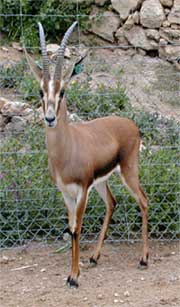 |
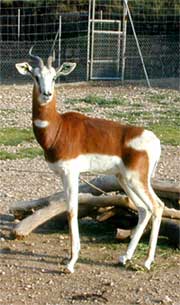 |
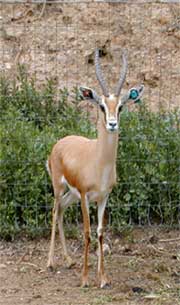 |
Gazella
cuvieri |
Gazella
dama mhorr |
Gazella
dorcas neglecta |
We are currently examining whether inbreeding affects sperm function during capacitation and acrosomal exocytosis. Furthermore, we are interested in finding out if inbreeding has deleterious effects on sperm DNA integrity since this may not affect sperm function but may have negative consequences on embryo development and survival.
Use of reproductive technologies to facilite gene flow between populations
To avoid inbreeding depression it is necessary to maintain or enhance gene flow between populations. The exchange of animals is problematic because it involves risks for the animals, newcomers may carry new pathogens, integration into the social groups is difficult, and transport is expensive in the case of large-bodied animals. Reproductive biotechnologies offer alternatives which may improve the genetic management of captive breeding programmes. Techniques of interest are the cryopreservation of gametes and the development of artificial insemination or in vitro embryo production and embryo transfer techniques.
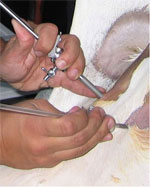 |
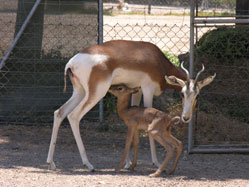 |
Semen cryopreservation extends the reproductive lifespan of individuals indefinitely, and artificial insemination allows the exchange of gametes between populations. We have developed cryopreservation protocols for the three species of gazelles, and found that the diluents which rendered the best results differed between the three species (Garde et al. 2003). The differences between species in the ability to withstand freezing and thawing were inversely related to the average values of inbreeding in those populations. Thus, inbreeding not only affects semen quality, but also makes spermatozoa more vulnerable to freezing. Although we managed to cryopreserve spermatozoa from these species, results made clear that in only one species (G. dorcas) the success was sufficient to start the collection of sperm samples for a genetic resource bank. In the other two species, further work is needed to analyse factors affecting the success of cryopreservation and to develop better protocols. Work currently under way examines the effects of diluent components and methods of semen handling on the ability of spermatozoa to survive freezing and thawing.
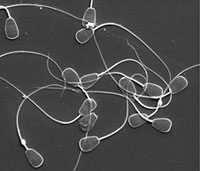 |
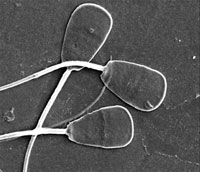 |
Artificial insemination with frozen semen increases the efficiency of
captive breeding, since it becomes possible to choose matings that will
minimise inbreeding without having to stress animals by moving them
between social groups, and to avoid behavioural incompatibilities which
may otherwise prevent matings which may be convenient from the point
of view of genetic management. Conditions necessary for a successful
artificial insemination need to be explored in detail, especially when
the reproductive physiology of a species is not well known as is the
case with these gazelle species. We have begun to develop artificial
insemination techniques in the Mohor gazelle (G. dama mhorr).
This has involved, first, the hormonal characterisation of female ovarian
cycles to synchronise oestrus. We have carried out laparoscopic intrauterine
artificial insemination under anaesthesia, using frozen-thawed semen,
in the Mohor gazelle and we have explored the effect of different intervals
between end of cycle synchronisation and timing of insemination. As
a result of this work, a healthy male calf was born in June 2005 after
a normal gestation of 202 days. This is the first birth in the world
of a gazelle using artificial insemination with frozen semen. For more
information click here.
We consider that it is also important to use and preserve female gametes
in order to retain as much genetic diversity as possible. To this end,
we are working on the development of in vitro embryo production techniques
in the Mohor gazelle. We are now analysing protocols for superovulation
and conditions affecting the quality of oocytes during subsequent in
vitro maturation and fertilisation. Factors influencing in vitro embryo
development are also being analysed as are conditions for embryo transfer.
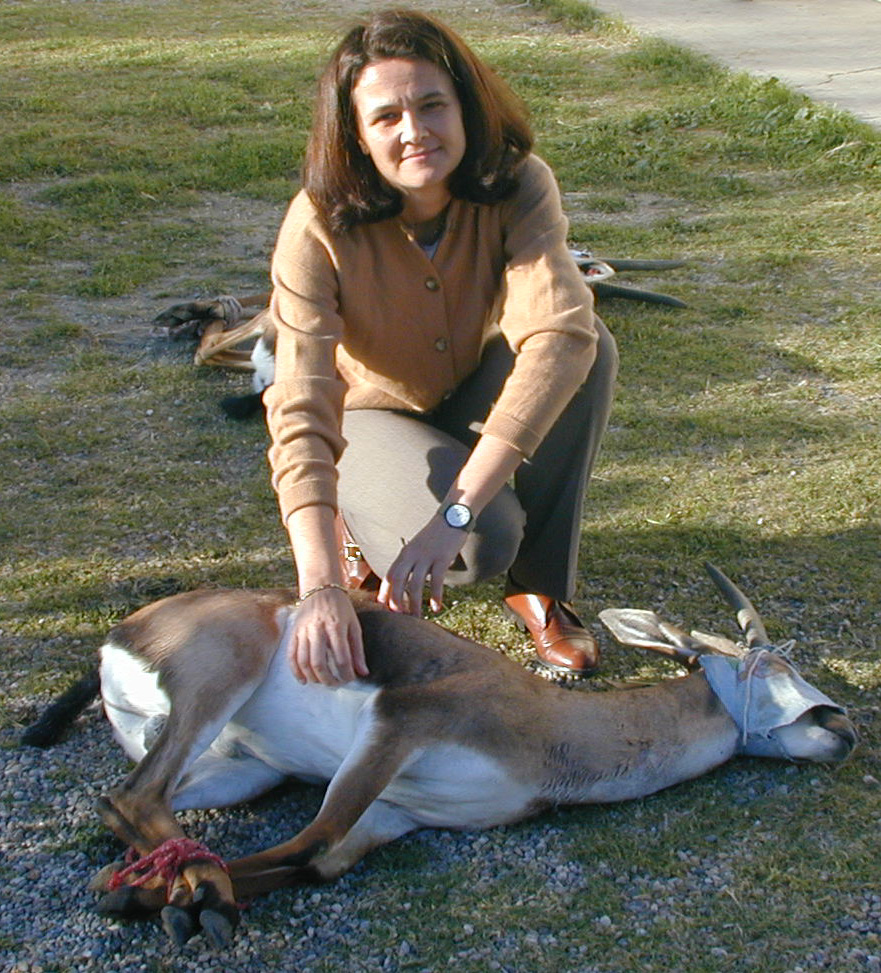
Collaborators:
• Julián Garde, Instituto de Investigación en Recursos
Cinegéticos (CSIC-UCLM-JCCM), Albacete (Spain).
• Gerardo Espeso, Parque de Rescate de Fauna Sahariana,
Estación Experimental de Zonas Aridas
(CSIC), Almeria (Spain).
• Sergio Ledda, Dipartimento di Biologia Animale, Facoltà
di Medicina Veterinaria, Università di Sassari,
Sassari (Italia).
• Fiammetta Berlinguer, Dipartimento di Biologia Animale, Facoltà
di Medicina Veterinaria, Università di Sassari,
Sassari (Italia).
• Don Evenson, Department of Chemistry and Biochemistry, South
Dakota State University, Brookings SD (USA).
The
captive breeding programmes for these three species of gazelles are
run by the Estación Experimental de Zonas Aridas (CSIC) at the
Rescue Park of Saharian Fauna
http://www.eeza.csic.es/eeza/Parque.htm
Back to projects